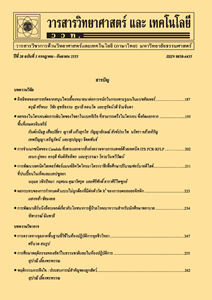ชิปอิเล็กโทรเวททิงเพื่อการตรวจวัดความเข้มข้นของคลอรีนโดยใช้โทรศัพท์เคลื่อนที่
Main Article Content
Abstract
บทคัดย่อ
งานวิจัยนี้ได้พัฒนาระบบของไหลจุลภาคให้สามารถผสมสารละลายแบบอัตโนมัติบนชิปโดยใช้หลักการของวาล์วอิเล็กโทรเวททิง โครงสร้างของวาล์วประกอบไปด้วยขั้วไฟฟ้าทองและช่องทางไหลจุลภาคที่ทำด้วยวัสดุโพลีไดเมททิลไซลอกซ์เซน เพื่อให้ทำหน้าที่เป็นตัวแยกสารละลายเอาไว้ที่บริเวณการผสม วาล์วจะเปิดเมื่อสารละลายอิเล็กโทรไลต์เคลื่อนที่ผ่านขั้วไฟฟ้าสังกะสีของเซลล์ไฟฟ้าเคมีซึ่งอยู่ที่ปลายช่องทางไหลจุลภาค ทำให้ศักย์ไฟฟ้าจำนวน -0.82 V ถูกป้อนไปยังขั้วไฟฟ้าทองที่ทำหน้าที่เป็นขั้วไฟฟ้าผสมเนื่องจากมีการเชื่อมต่อกับเซลล์ไฟฟ้าเคมี ผลที่เกิดขึ้นจะทำให้พื้นผิวของขั้วไฟฟ้าทองเปลี่ยนสมบัติเป็นไฮโดรฟิลิคและวาล์วจะเปิดอัตโนมัติ ทำให้สารละลายทั้งสองผสมกันภายในบริเวณการผสม เพื่อแสดงการประยุกต์ใช้ชิปอิเล็กโทรเวทจึงได้ตรวจวัดการเปลี่ยนสีเพื่อวิเคราะห์ค่าความเข้มข้นของคลอรีนจากภาพที่ถ่ายโดยใช้โทรศัพท์เคลื่อนที่ โดยหยดสารละลายคลอรีนในช่องใส่สารด้านหนึ่งก่อน จากนั้นนำสารละลายโพแทสเซียมไอโอไดด์-น้ำแป้งที่ผสมกับโพแทสเซียมคลอไรด์สำหรับใช้เป็นสารละลายอิเล็กโทรไลต์หยดในช่องใส่สารที่มีขั้วไฟฟ้า Ag/AgCl แล้วจะเคลื่อนที่ไปที่ปลายช่องทางไหลด้วยแรงคาปิลลารี ในขั้นนี้สารละลายจะถูกกั้นด้วยไมโครปิลาร์และจะผสมกันอย่างอัตโนมัติเมื่อวาล์วถูกเปิด จากการทดลองได้แสดงกราฟปรับเทียบอัตราส่วนสีกับค่าความเข้มข้นของคลอรีนในช่วง 0.2-20.0 ppm
คำสำคัญ : ห้องปฏิบัติการบนชิป; อิเล็กโทรเวททิง; การตรวจวัดคลอรีน; ระบบของไหลจุลภาค; โทรศัพท์เคลื่อนที่
Abstract
In this research, microfluidic lab-on-a-chip (LOC) devices were developed to perform autonomous mixing on a single chip using an electrowetting-based valve. A structure of the valve was composed of a gold electrode and a polydimethylsiloxane (PDMS) microchannel to separate solutions in a mixing area. The valve was opened when an electrolyte solution reached a zinc electrode of an electrochemical cell at the end of the flow channel. The potential of the mixing electrode (Au) was changed to -0.82 V since the cell was electrically connected to the valve. As a result, the mixing electrode becomes hydrophilic making the valve opened and then two solutions were mixed inside the mixing area. To demonstrate the applicability of the electrowetting-based LOC device, the colorimetric detections for the analysis of chlorine concentration using mobile phone camera were performed. A chlorine solution was filled in a PDMS microchannel and another solution containing Potassium Iodide-Starch solution in potassium chloride (KCl) being electrolyte solution was dropped on Ag/AgCl electrode and transported by capillary action in an another PDMS microchannel. The solutions were confined outside the mixing area by micropillar structures and then were mixed by the automatic operation at mixing area when the valve opened. The experimental results showed the calibration curve of the color ratios with corresponding 0-20 ppm chlorine concentrations.
Keywords: lab-on-a-chip; electrowetting; chlorine measurement; microfluidic; mobile phone


